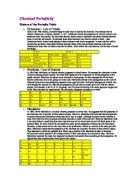However most chemists considered this to be a coincidence, as too few elements were known, values of atomic masses were uncertain and the triads covered one sixth of the known elements.
Chemists were encouraged to look for trends between properties of elements and their relative atomic masses
Later in the century more elements were known and their relative Atomic Masses could be calculated more accurately
Newlands Octaves
In 1866, Newlands came up with the law of Octaves. This idea was more developed than Dobereiners Triads.
Newlands suggested that when the elements were arranged in the order of Relative Atomic Mass (below), any one element had properties similar to those of the element eight places in front of it and eight places behind it in the table.
Newlands Octaves: The eighth element is a kind of repetition of the first like the eighth note of an octave in music.
His work wasn’t very well received by the scientific community because there weren’t any empty spaces his table which assumed that all the elements had been discovered even though 4 elements had been discovered a few years before his work was published so the discovery of a new element could throw the idea out of the window. In addition to this he had to place some of the elements in one space in order to ensure a pattern of repeating octaves, e.g. Ro and Ru, and some elements that were dissimilar were placed in the same group e.g. F, Cl and Br were placed in the same group as Co and Ni.
Lothar Meyer and Dimitri Mendeleev both published results that supported the idea of periodicity.
Lothar Meyer plotted a graph of molar volume against the Relative Atomic Mass, which produced a curve with regular peaks and troughs. The peaks had alkali metals: sodium, potassium, rubidium, and caesium. Each fall and rise to a peak, corresponded to a period like the waves. In each period a number of physical properties other than atomic volume also fell and rose, such as valence and melting point. Figure below shows the curve obtained by Lothar Meyer when he plotted the atomic masses and the respective atomic volumes.
Each peak started with a new period. Note the graph shows the inert gases which were discovered later in 1894 by William Ramsey. These elements represented a new group.
Dimitri Mendeleev
The most famous work that was done in developing the periodic table was done by a Russian chemist, Dmitri Mendeleev. Mendeleev developed his periodic table in 1869. It was a table, not a graph.








